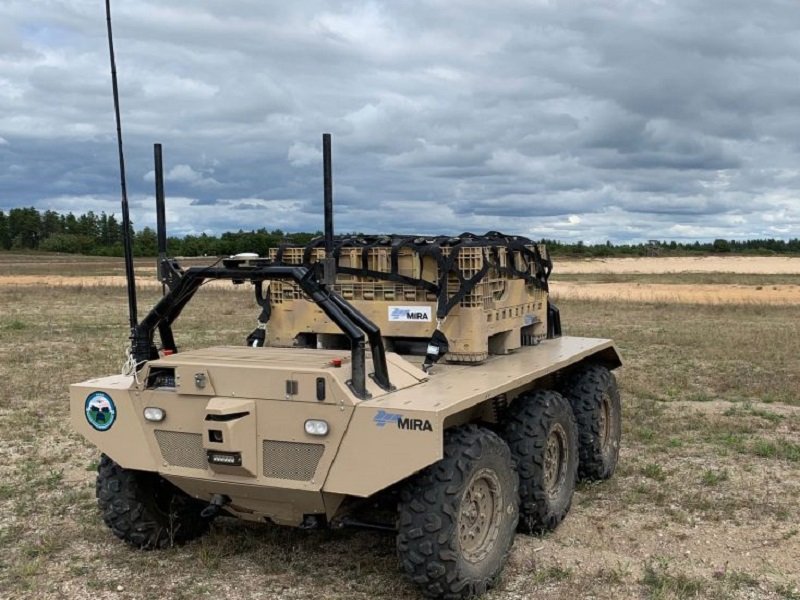Land
Robot wars: The battle for automated ground capability
Armed forces are increasingly experimenting with and investing in uncrewed ground vehicles, suggesting they will play a key role in near-future land warfare. Norbert Neumann explores the capabilities of current ground robot programmes.
Military vehicle automation has proliferated in all domains. In the air or on water, vehicles can navigate relatively unimpeded. On land, especially off-road, uncrewed ground vehicles (UGVs) face difficulties steering away from obstacles and challenges posed by various terrains. The requirement for ground robotics to carry out tasks while ensuring an uninterrupted and uncompromised mission sets the bar high.
Ground automation technology is not quite at the stage where commanders could build operations around them, but the challenges have not stopped militaries from developing and testing UGV capabilities. The attraction of uncrewed vehicles lies in their versatility and capability to remove humans from harm’s way. They come in different sizes, shapes and capabilities to fulfil a range of functions.
European programmes
Flensburger Fahrzeugbau Gesellschaft (FFG) and partner Israel Aerospace Industries/ELTA Systems (IAI/ELTA) took part in practical tests of the ELTA Systems REX MK-II combat UGVs by the German Armed Forces, Bundeswehr.
IAI official tells Global Defence Technology: “It proved to be a particularly versatile and robust UGV that could provide support to ground dismounted forces in the execution of their missions and significantly enhance the performance of the platoon.”
IAI/ELTA participated in the training at the invitation of the Fraunhofer Institute, German Army Concepts and Capabilities Development Centre under a study called ‘UGV to support dismounted forces, also known as Cargo Mule’.
“During the field trial, the Bundeswehr had the opportunity to test the REX MK-II’s driving autonomy and enjoy the UGV’s adaptability” the official explains.
The third and last of the test series took place in September, with the emphasis on the UGV participation in live-fire training.
The next phase in military robotics, with UGVs and UAVs operating as an integral part of the combat team, will contribute to a high level of mission autonomy and accuracy.
The company says the platform was designed to execute various tasks, including carrying and activating different payloads, equipment and recovering wounded soldiers quickly. The highly-manoeuvrable UGV supports up to 1.25t of payload and the electric hybrid system allows for a 300km range or 70km in electric stealth mode.
IAI/ELTA says it has followed battlefield developments and adapted its AI-based robotic and autonomous solutions to meet current and future threats.
“We believe that the next phase in military robotics, with UGVs and UAVs operating as an integral part of the combat team, will contribute to a high level of mission autonomy and accuracy,” the company official adds.
Another significant European UGV programme is run by the UK Ministry of Defence’s (MOD) Defence Science and Technology Laboratory (Dstl).
Under project Theseus. the agency has been researching the potential use of autonomous and remote-controlled systems for resupply operations to provide greater capability and utility for the Army since 2020.
Also in 2020, the MOD purchased three each of Horiba Mira’s Viking and QinetiQ’s Titan UGV. Both vehicles can run on an electric battery or in a diesel-electric hybrid mode and the Viking can carry payloads up to 600kg and the Titan 750kg.

// Caption: The UK MOD purchased three Horiba Mira Viking UGVs in 2020. Credit: Horiba Mira
The programme seeks to increase understanding of the potential and limitations associated with operating UGVs. This will reduce risks associated with acquiring systems to meet the Joint Tactical Autonomous Resupply and Replenishment project capability. The tests will also help develop deeper knowledge for the army’s future deployment of more advanced autonomous system capabilities.
UGVs in Asia-Pacific
Major South Korea defence contractor Hanwha Defense and a division of the Republic of Korea Armed Forces began the testing operation of a six-wheeled multi-role UGV, called intelligence UGV (I-UGV).
The 6x6 is a newer version of the multi-purpose 4x4 UGV (M-UGV) the company developed in 2019 and showcased at the latest Defence and Security Equipment International expo.
Both platforms can conduct reconnaissance, communication relay, logistic and casualty transport and close combat missions. They can be remotely controlled or can operate autonomously on the battlefield for reconnaissance purposes.
The I-UGV is equipped with Hanwha Defense’s RCWS AI-powered weapon turret system. The weaponry detects gunfire sounds and can shoot back in the direction of the origin of the sound. When remotely controlled and the radio signal is lost, the ground vehicle will seek to re-establish communication with the control room. If re-linking is unsuccessful, the robot will return to its starting point.
Elsewhere in the region, the Chinese People’s Liberation Army’s 71st Group has carried out exercises that included the deployment of UGV for ammunition delivery. Details and capabilities of the system used in the operation are not known, but it reportedly overcame terrain obstacles while carrying loads.
Australia has also been investing in UGVs. The Morrison Government has awarded a $3.3 million contract to Brisbane Robotics and an AI company Cyborg Dynamics Engineering to develop an unmanned combat vehicle the likes of which have never been made before in Australia.
The project seeks to integrate various Australian technologies into the modular platform to enhance load-carrying and fire support capabilities while also protecting dismounted troops.
Minister for Defence Industry and Minister for Science and Technology Mellissa Price said in a statement: “The government’s investment in innovation through the Defence Innovation Hub is critical to ensuring defence maintains a capability advantage as Australia’s strategic environment continues to rapidly evolve.”
The contract will also experiment with onboard AI target recognition and advanced driving technologies to support single-person operation.
Last month the Australian Department of Defence also announced a successful milestone of a $3.5m Australian Army project that is working to develop a convoy of autonomous trucks.
// Main image: The German Armed Forces trialled the IAI/ELTA Systems Rex-MK-II UGV. Credit: IAI/ELTA Systems